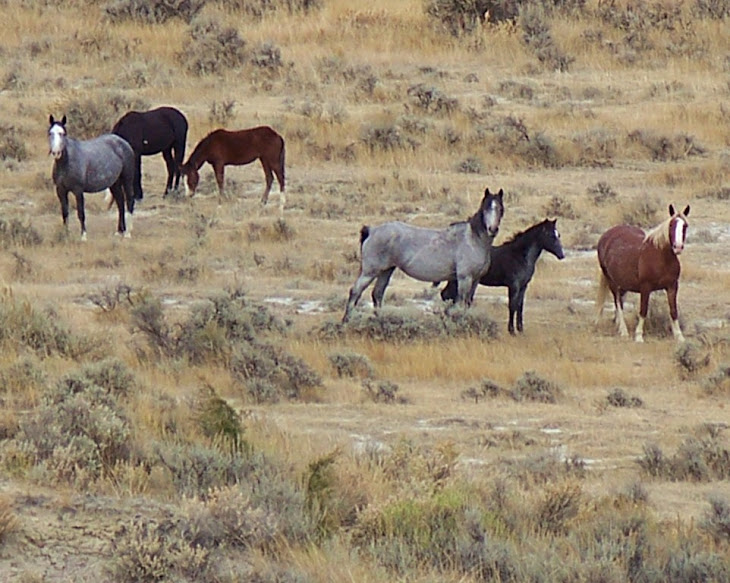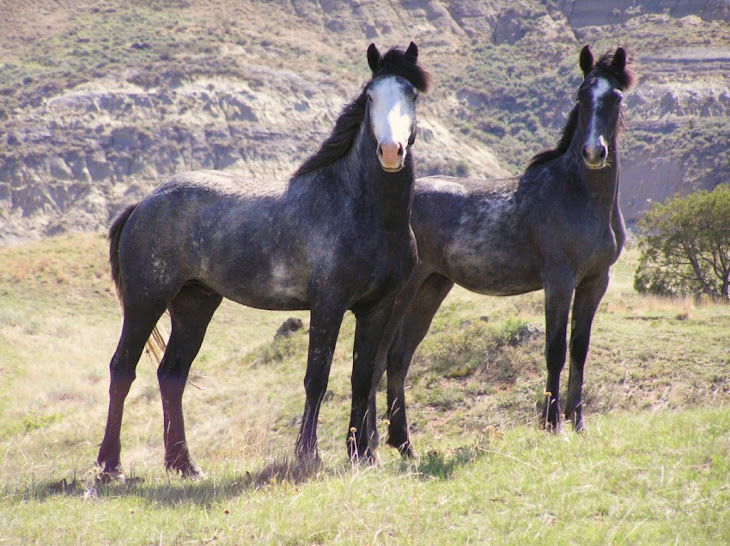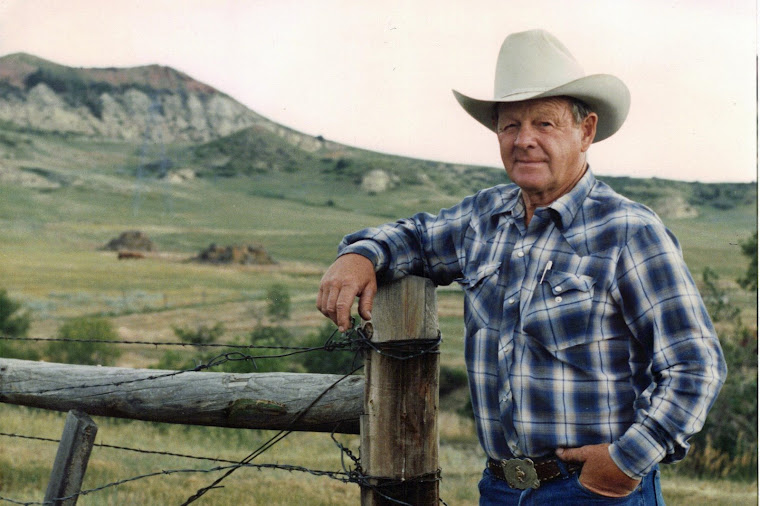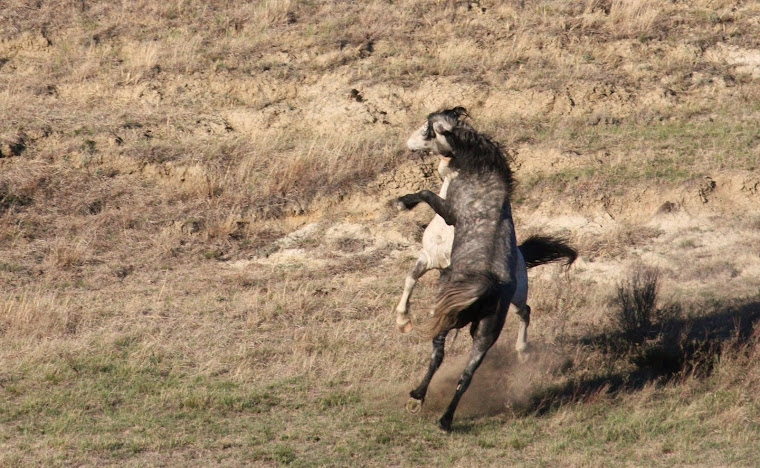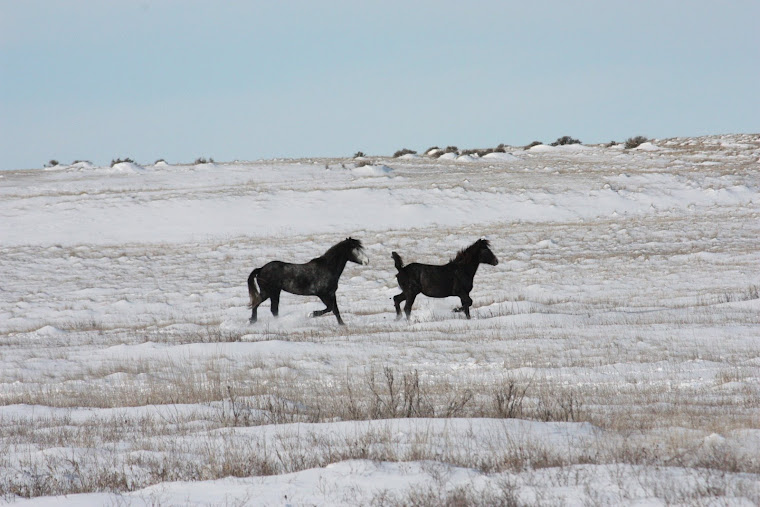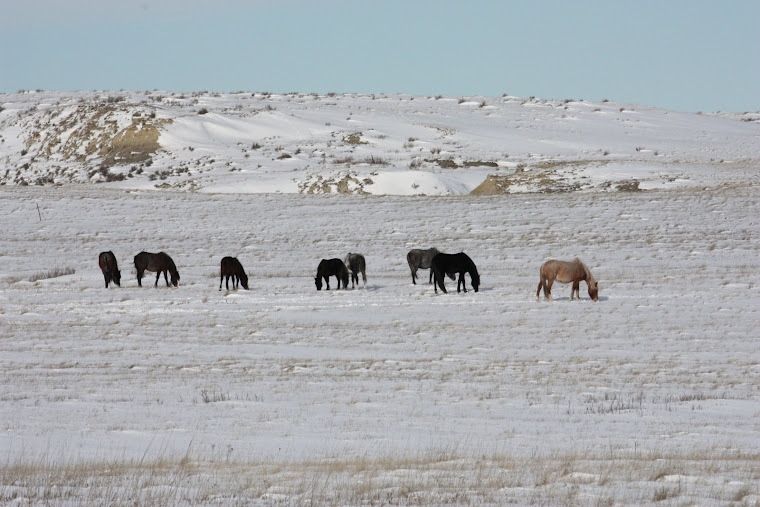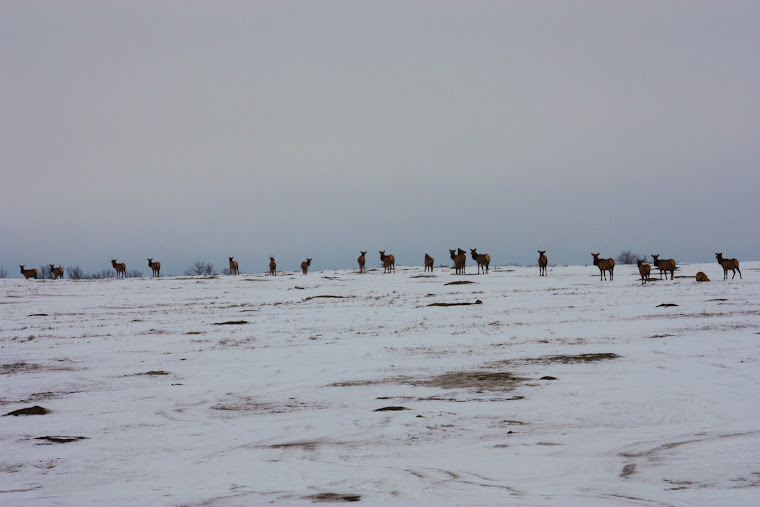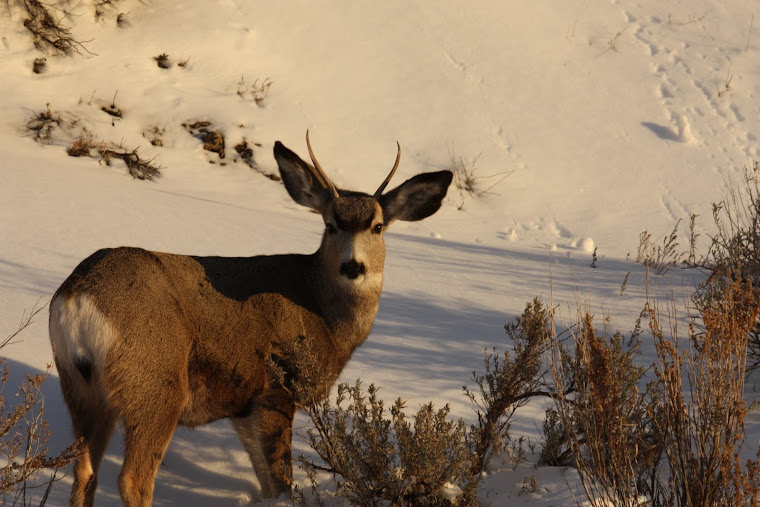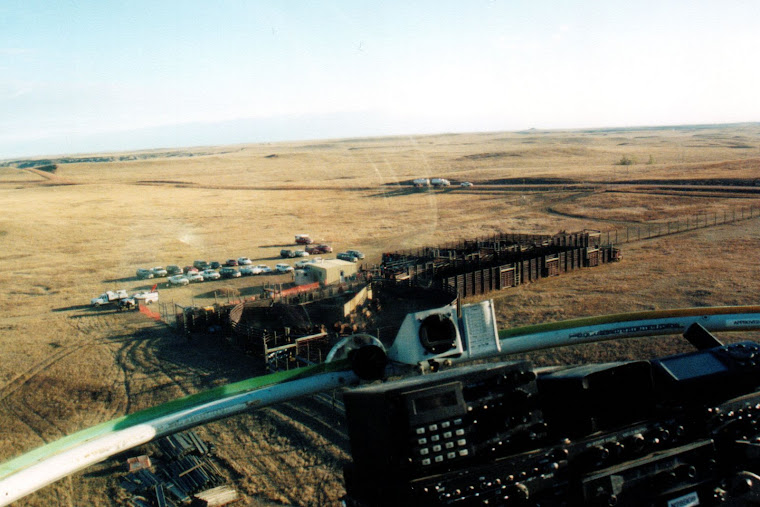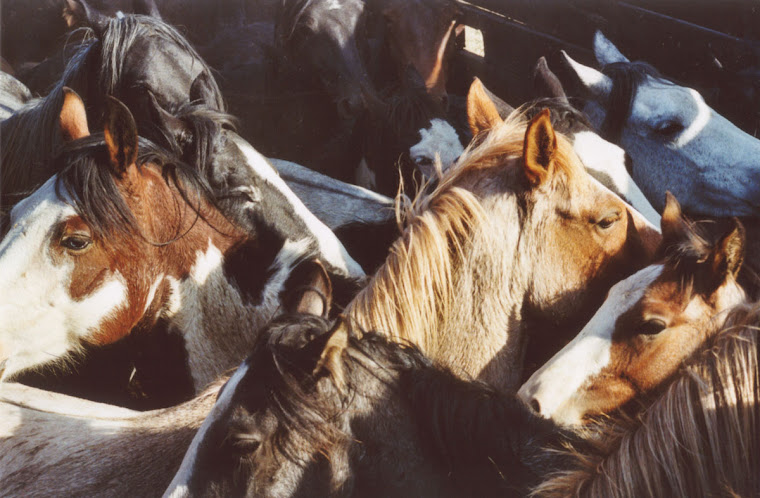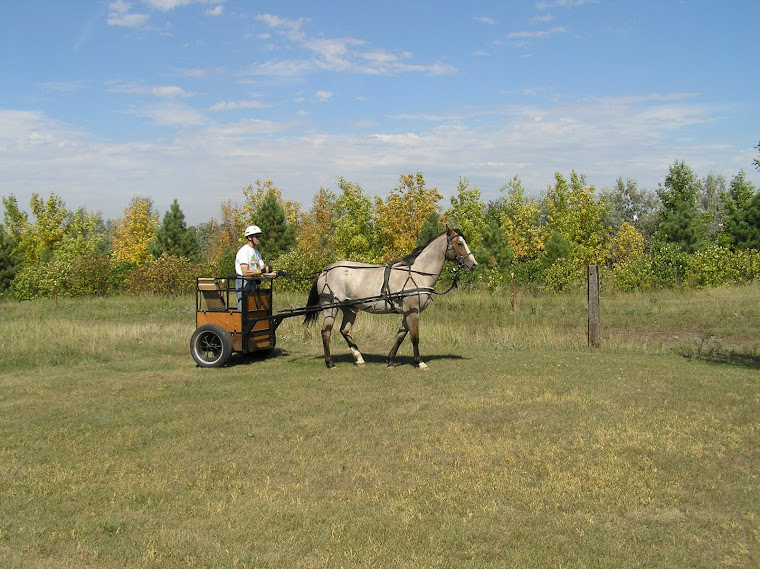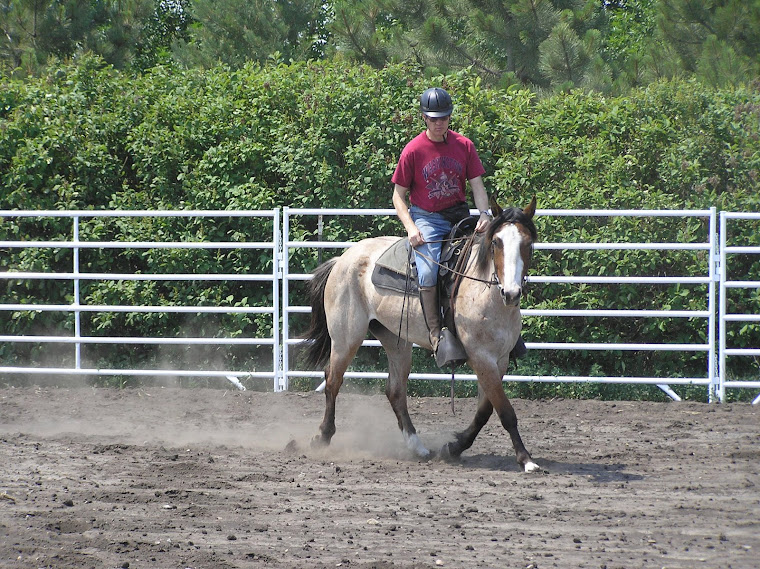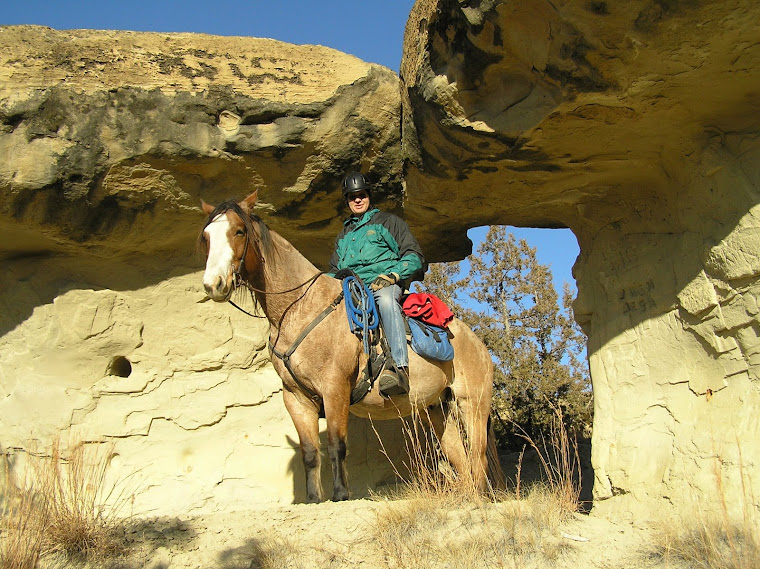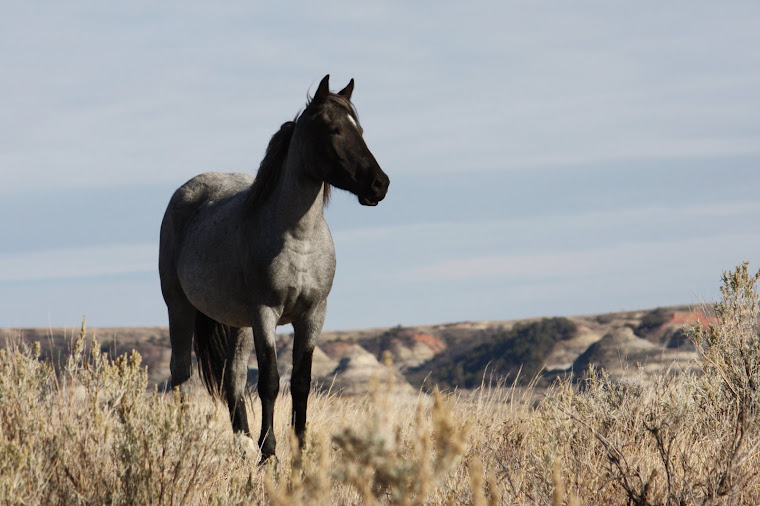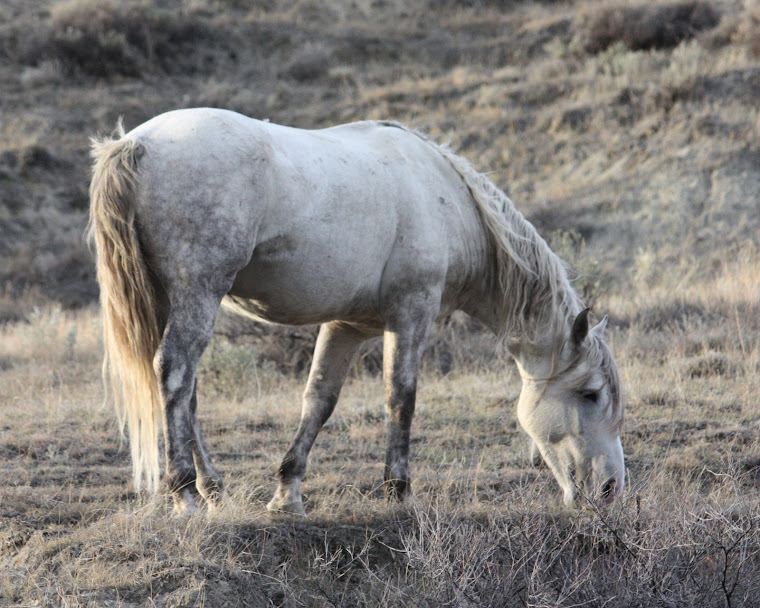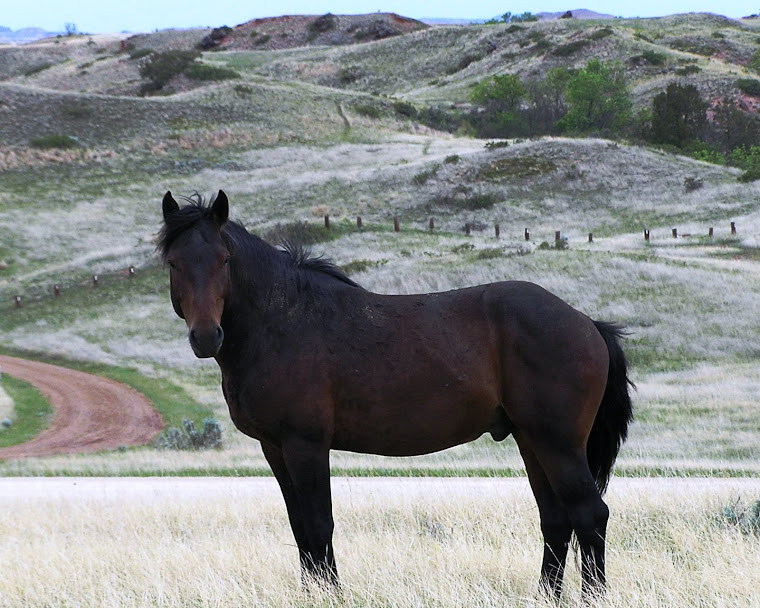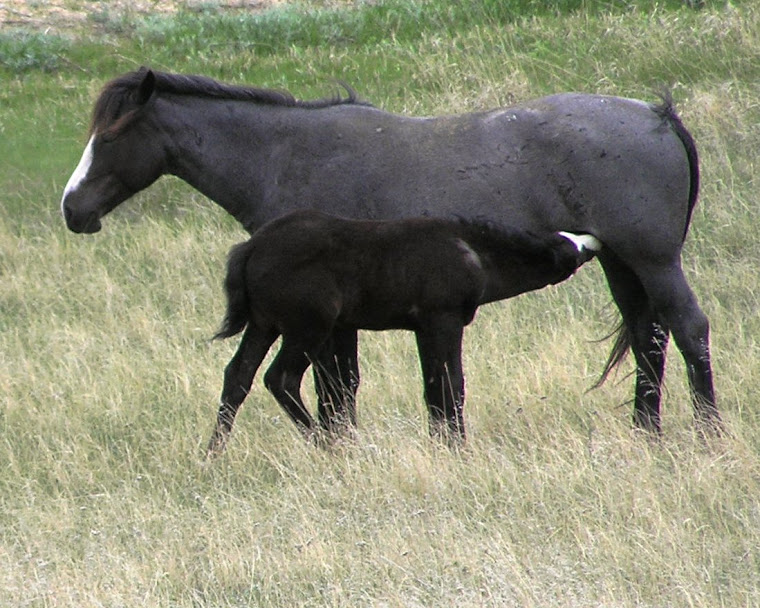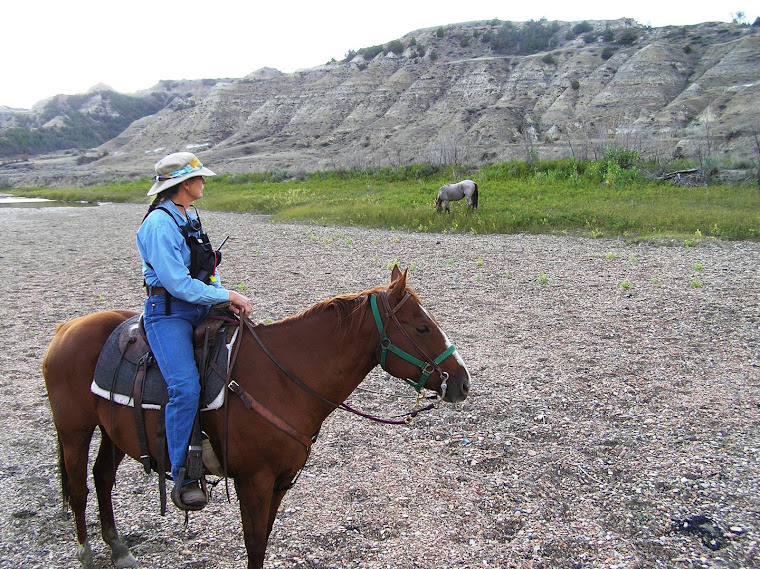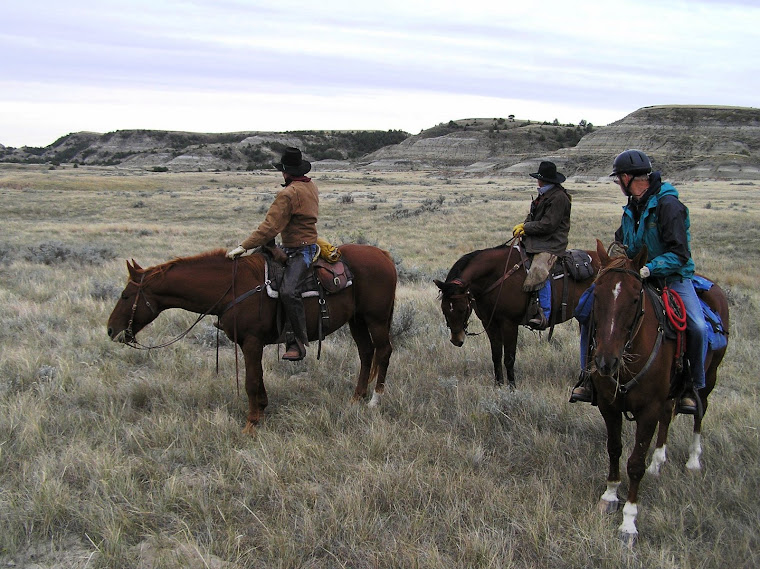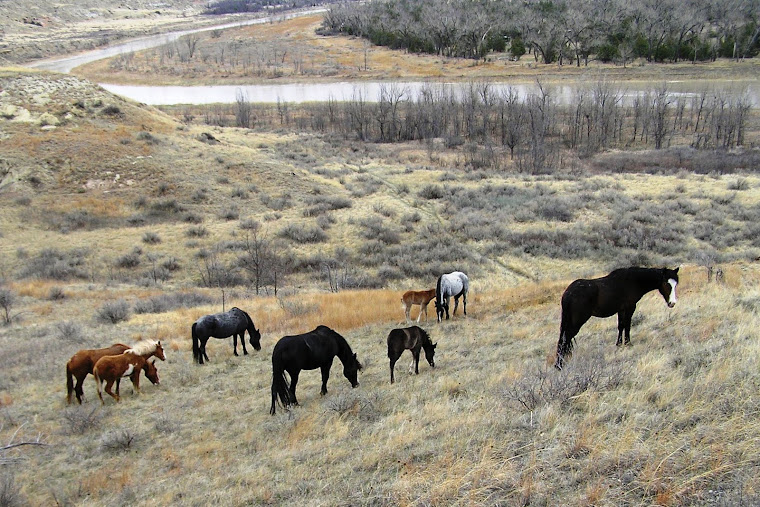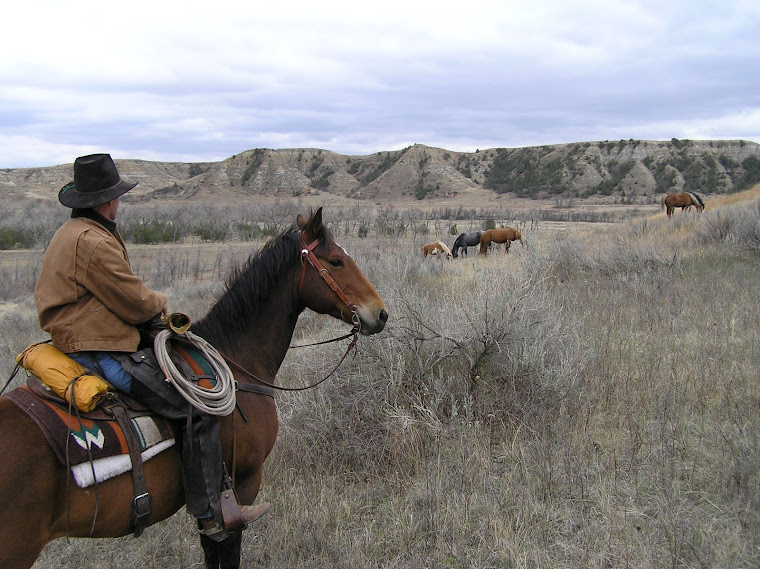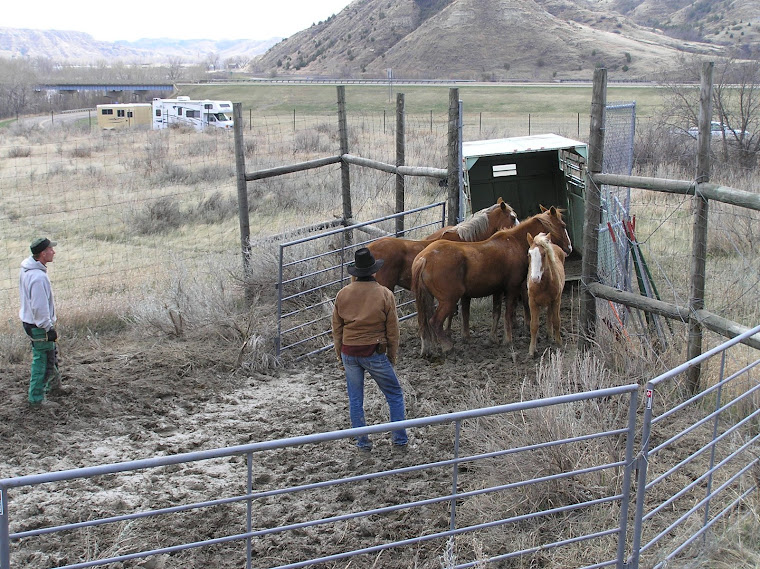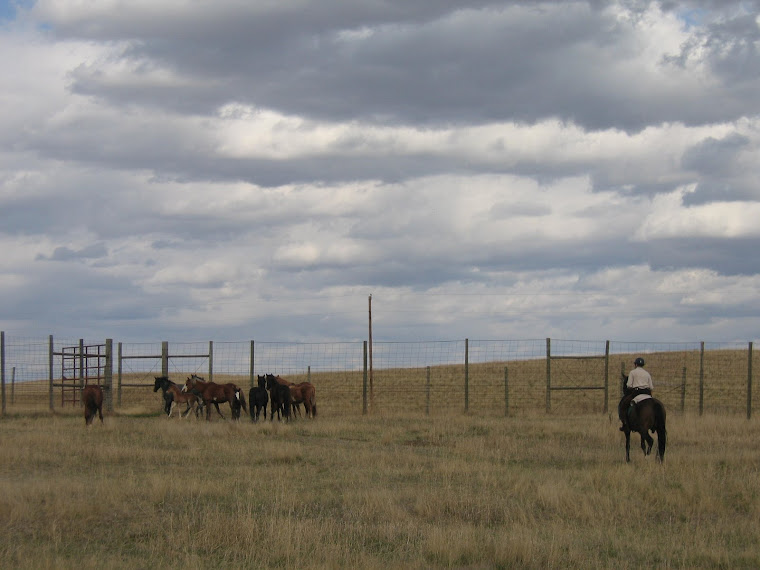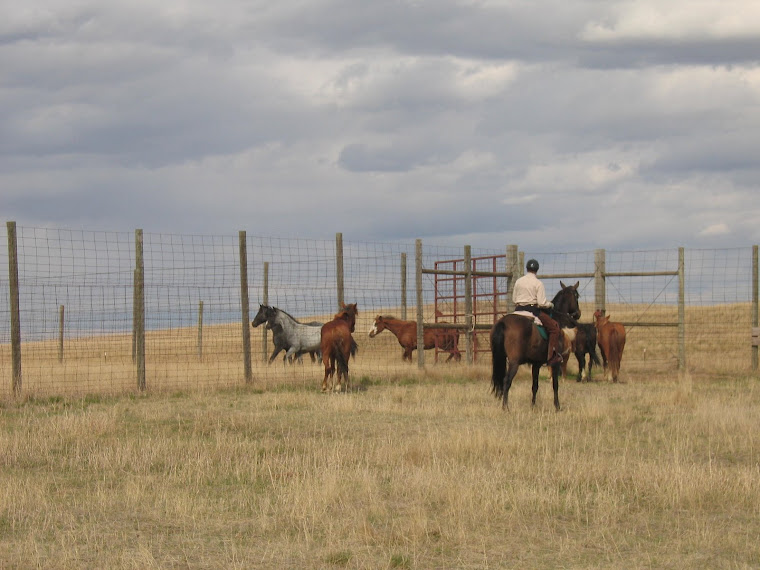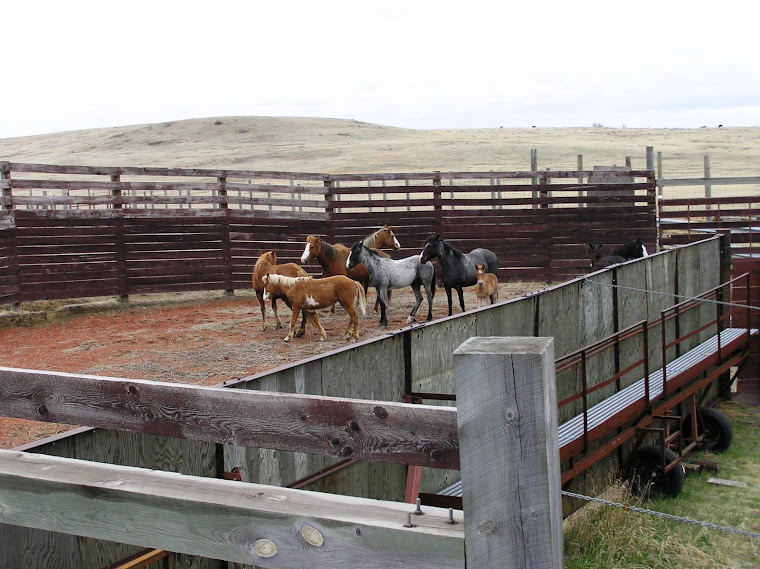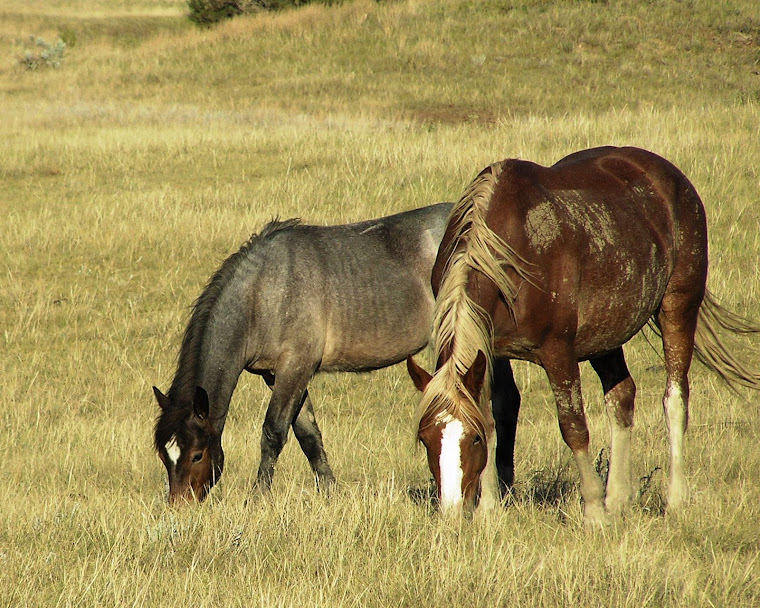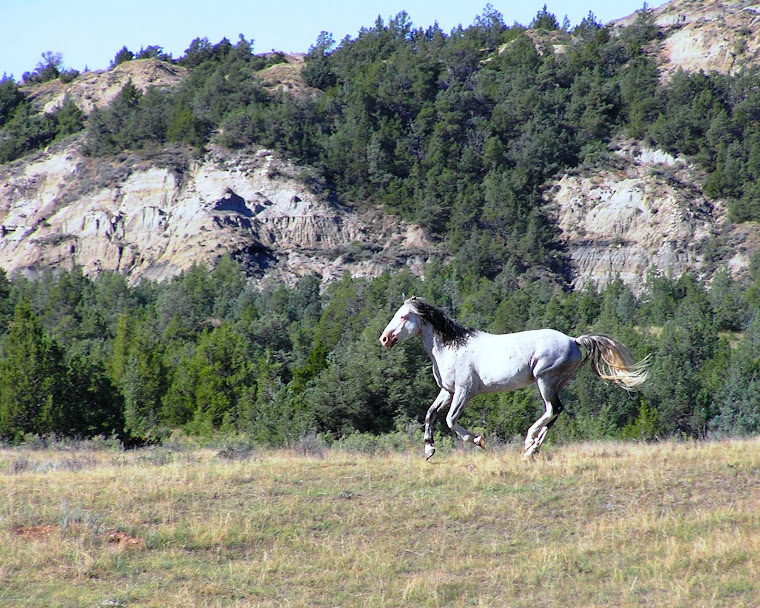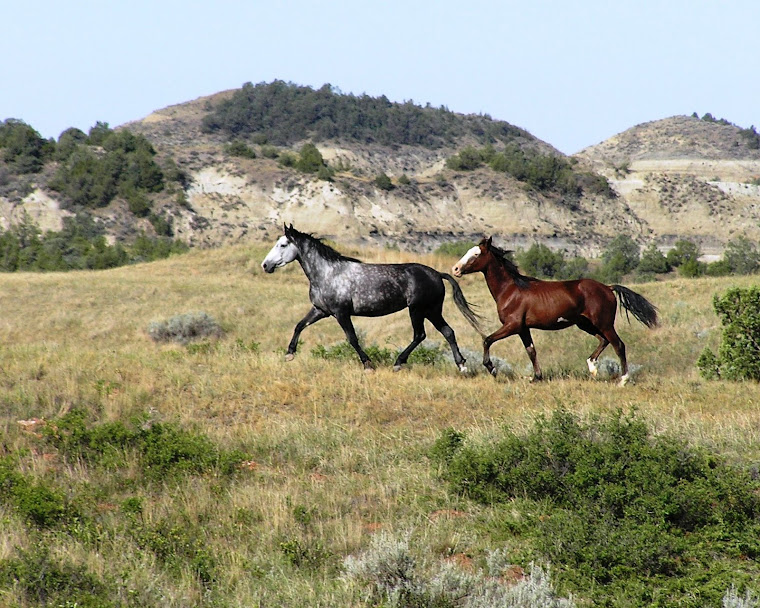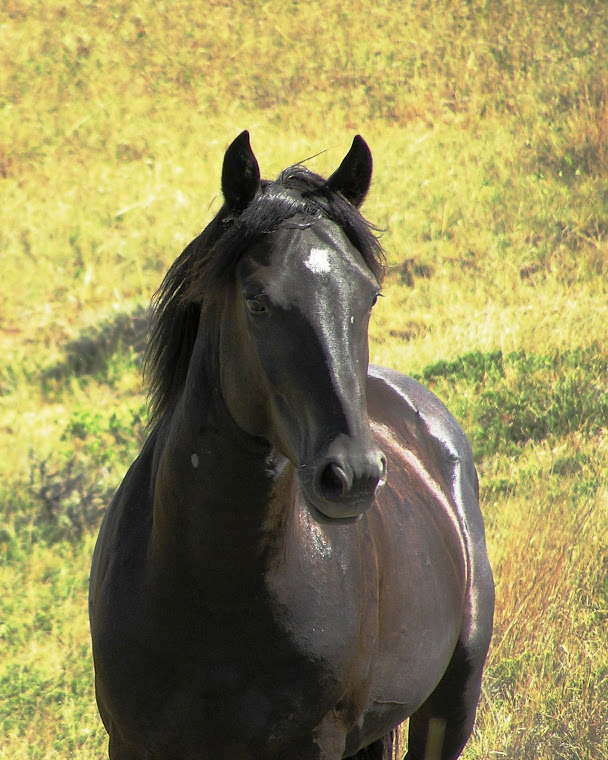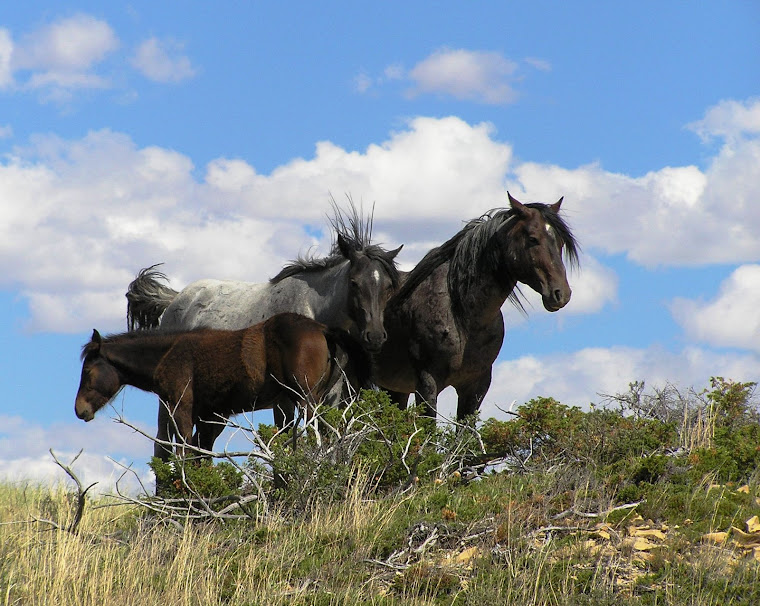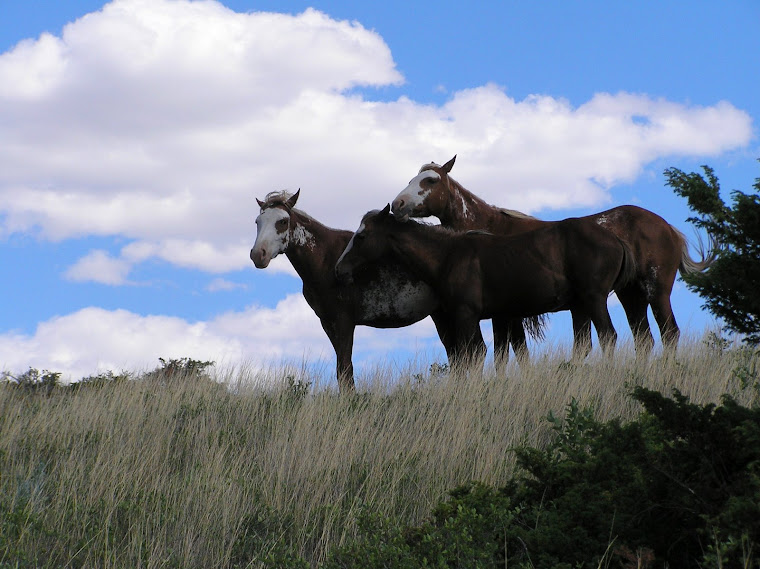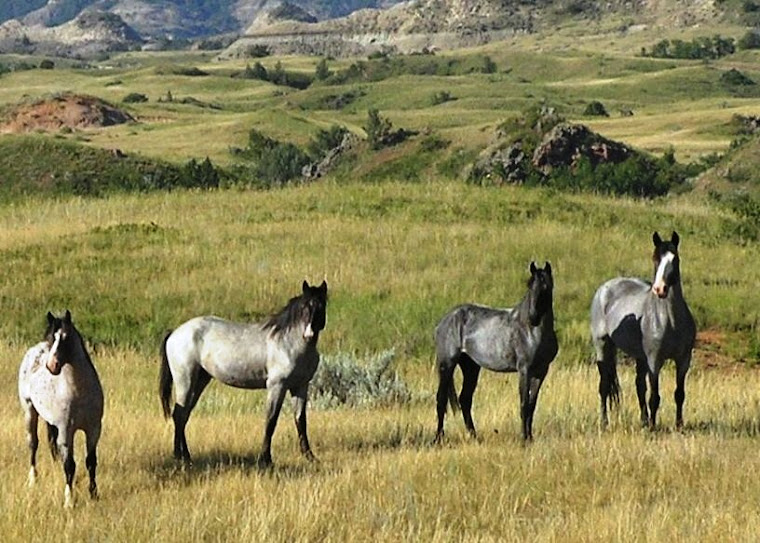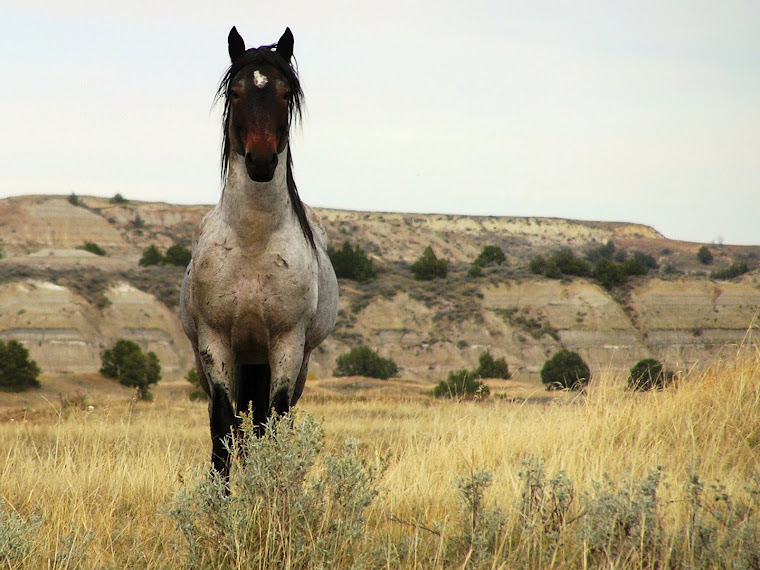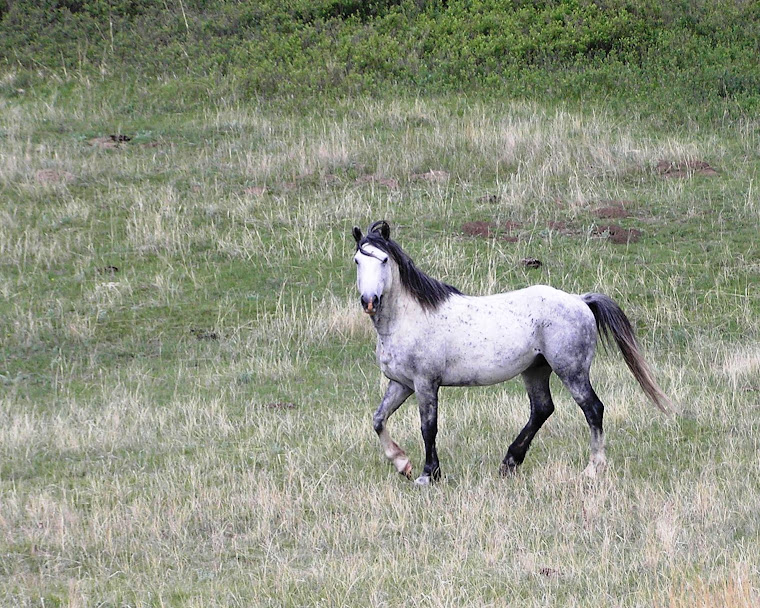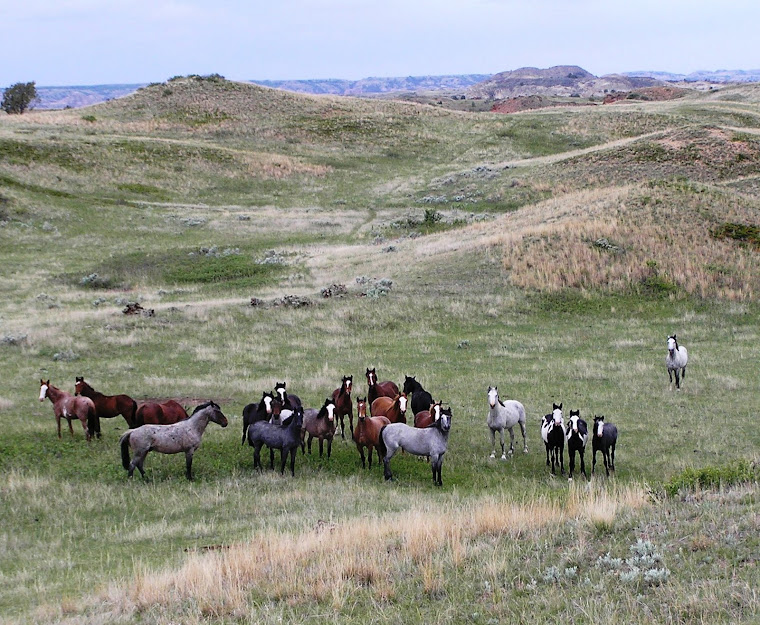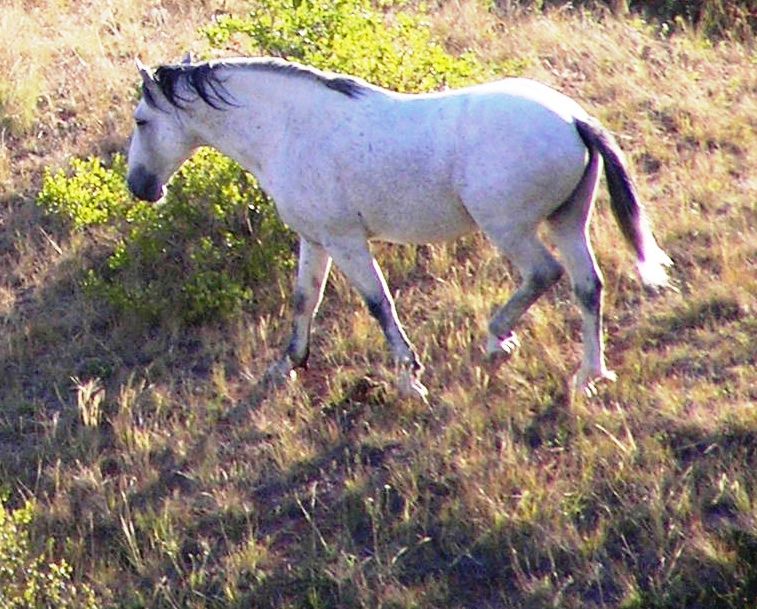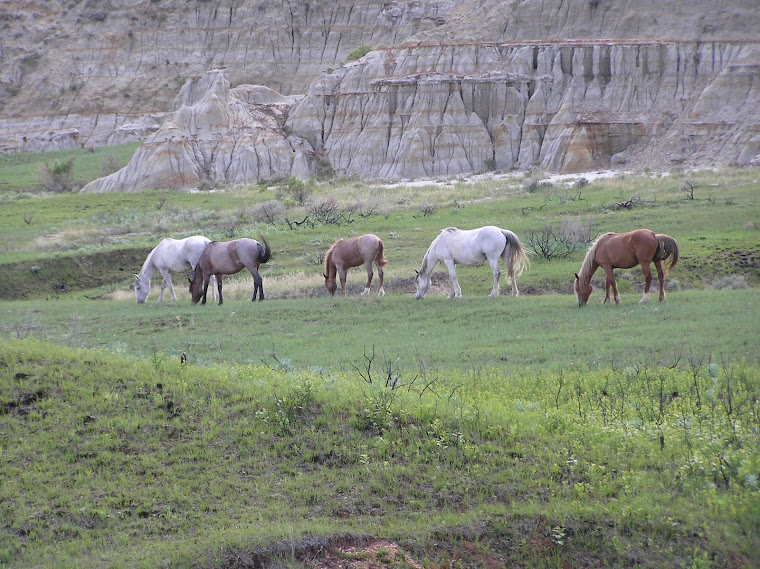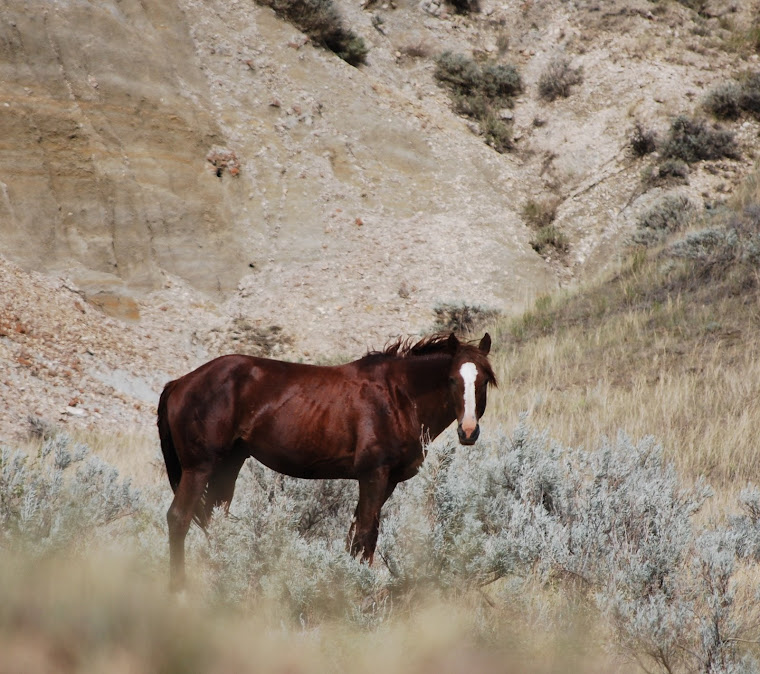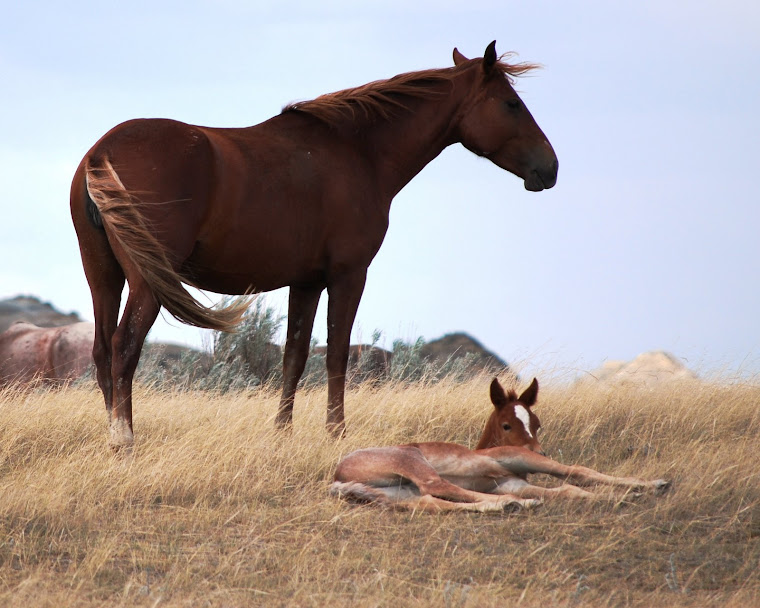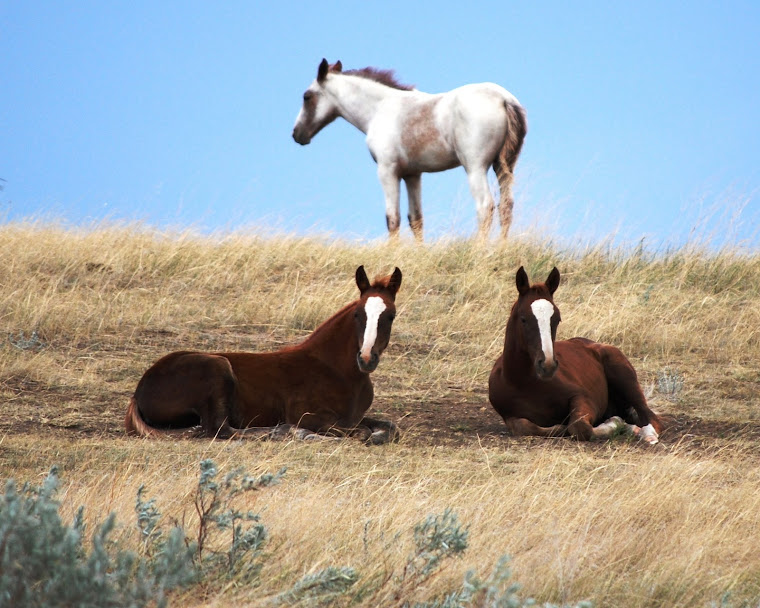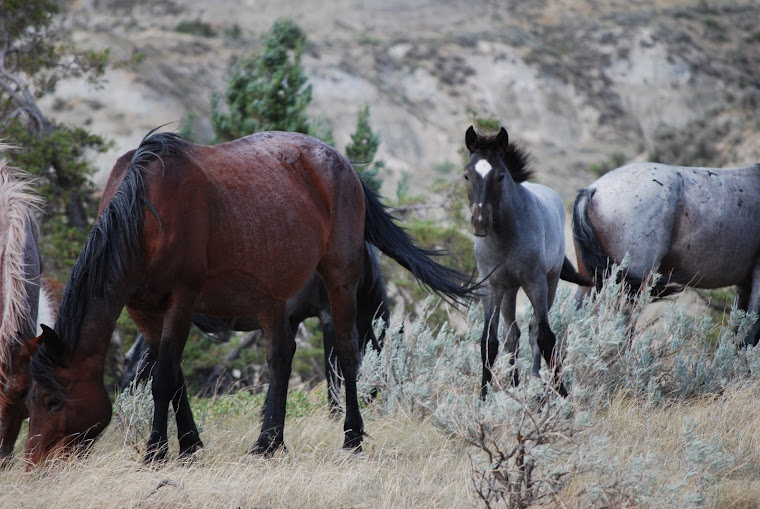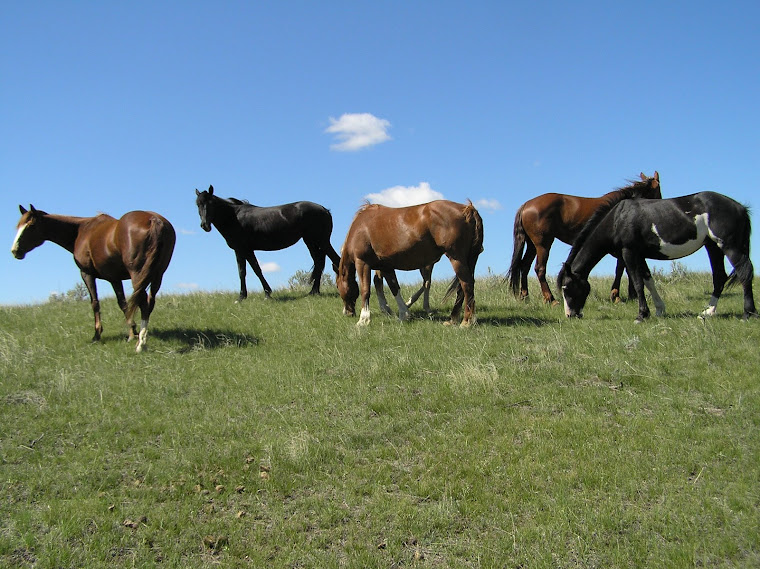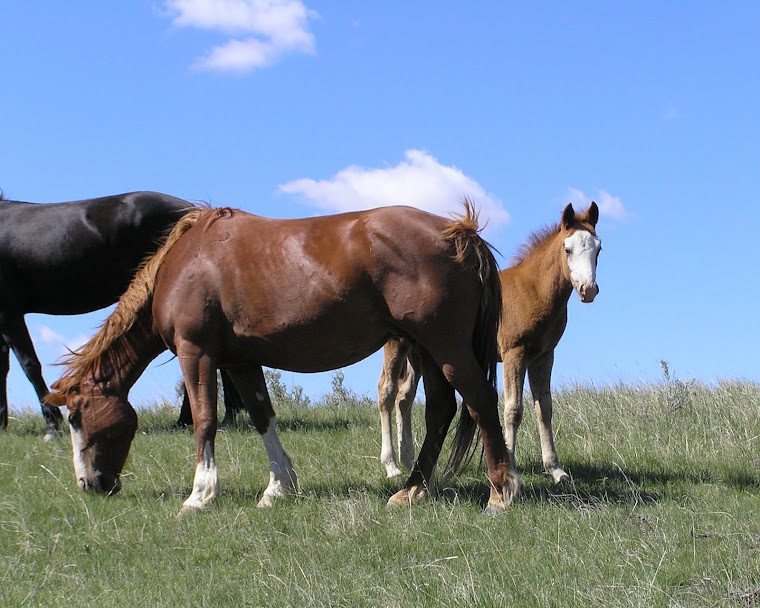Saturday, December 5, 2015
The new printed Field Guide to the Wild Horses of Theodore Roosevelt National Park is now available online from Blurb. This new Guide has photos of ALL the horses in the park as of November, 2015. Individual photos of each horse were submitted by photographers from as far away as Germany. We thank each and every person who submitted the photos. The Guide is set up so that the horses are the easiest to find and identify by color and gender. Along with name, year of birth, color, and facial markings, their usual summer range is listed. In the back of the guide is a list of horses by band, a quick find list by alphabet and a map of the park showing popular horse hangouts. We hope you will enjoy the guide.
http://www.blurb.com/b/6689936-2016-guide-to-the-wild-horses-of-theodore-roosevel
Wednesday, September 2, 2015
Thursday, August 13, 2015
The story of Grace and her new horse, Lassen, in her own words
Photo by Rachel Abraham
Yesterday was a very exciting day at my house! I bought my first horse....and not just any horse.... Here is the story: Backtrack to when my older sister Rachel was 12 years old, she sold her llama and a few goats to buy a young mare that was rounded up in 2009 from the North Dakota Badlands. Rachel named her Autumn. Autumn was tamed by a man in Minnesota that also had several other horses for sale. Rachel was planning on buying a Nokota named Wokini. But, this young filly kept following Rachel around. Rachel turned around to see who kept following her and she and Autumn bonded. Rachel bought Autumn and finished out her training. Rachel is now 16. Rachel began yearly treks to the North Dakota Badlands, home of Theodore Roosevelt National Park and the wild horses, when Rachel was 13. All of Rachel's wild horse photos are taken there. The horses in TRNP are closely watched as they are part of a birth control study. Autumn's parents are Stormy x Cocoa, who have been together a long time. If horses married, these two would be married. They had Autumn in 2009. She is a beautiful bay roan. The next foal they had is Juniper, who is a solid like her sire. The next foal they had was Heritage, who disappeared. And the next foal they had was this spring. The birth control study team named her Lassen and she is identical to Autumn, with the addition of a little white star. I am now 13 years old and I have been talking and talking about training my own horse just like my sister did. Then out of nowhere my mom gets a call that Lassen has been selected for removal from the park and is now in the holding facility. These horses were once removed in large roundups via helicopter, but they are now rounded up a few at a time using low-stress techniques. Rachel and I were ecstatic! Imagine sisters both owning sister horses that look alike and training them. What is the probability of such a thing? The horses are full sisters born in the wild. Anything could have happened between 2009 when Autumn was born and 2015 when Lassen was born. These are wild horses - either one of them could have died, or Stormy could have been stolen by another stallion, or the baby could have died like their baby did last year. I have been saving my money for this very moment. I have saved my allowance and earnings from goats I have sold. Last night, there was an online auction to approved buyers and I bought Lassen!!! I will now be taming and training my very own wild horse. Rachel will be there right alongside me teaching me the skills I will need. Sisters and sisters. To follow these horses in the wild, like the FB page, "North Dakota Badlands Horse". They will be gathering up a few more next week for removal. You, too, can own your own wild horse!! Praise God for this awesome experience that has already begun! Thank you! Grace Abraham
Photo by Jamie Baldanza Claps
Yesterday was a very exciting day at my house! I bought my first horse....and not just any horse.... Here is the story: Backtrack to when my older sister Rachel was 12 years old, she sold her llama and a few goats to buy a young mare that was rounded up in 2009 from the North Dakota Badlands. Rachel named her Autumn. Autumn was tamed by a man in Minnesota that also had several other horses for sale. Rachel was planning on buying a Nokota named Wokini. But, this young filly kept following Rachel around. Rachel turned around to see who kept following her and she and Autumn bonded. Rachel bought Autumn and finished out her training. Rachel is now 16. Rachel began yearly treks to the North Dakota Badlands, home of Theodore Roosevelt National Park and the wild horses, when Rachel was 13. All of Rachel's wild horse photos are taken there. The horses in TRNP are closely watched as they are part of a birth control study. Autumn's parents are Stormy x Cocoa, who have been together a long time. If horses married, these two would be married. They had Autumn in 2009. She is a beautiful bay roan. The next foal they had is Juniper, who is a solid like her sire. The next foal they had was Heritage, who disappeared. And the next foal they had was this spring. The birth control study team named her Lassen and she is identical to Autumn, with the addition of a little white star. I am now 13 years old and I have been talking and talking about training my own horse just like my sister did. Then out of nowhere my mom gets a call that Lassen has been selected for removal from the park and is now in the holding facility. These horses were once removed in large roundups via helicopter, but they are now rounded up a few at a time using low-stress techniques. Rachel and I were ecstatic! Imagine sisters both owning sister horses that look alike and training them. What is the probability of such a thing? The horses are full sisters born in the wild. Anything could have happened between 2009 when Autumn was born and 2015 when Lassen was born. These are wild horses - either one of them could have died, or Stormy could have been stolen by another stallion, or the baby could have died like their baby did last year. I have been saving my money for this very moment. I have saved my allowance and earnings from goats I have sold. Last night, there was an online auction to approved buyers and I bought Lassen!!! I will now be taming and training my very own wild horse. Rachel will be there right alongside me teaching me the skills I will need. Sisters and sisters. To follow these horses in the wild, like the FB page, "North Dakota Badlands Horse". They will be gathering up a few more next week for removal. You, too, can own your own wild horse!! Praise God for this awesome experience that has already begun! Thank you! Grace Abraham
Thursday, May 14, 2015
“Preliminary
Results with GonaCon Immunocontraceptive Vaccine in Wild Horses at Theodore
Roosevelt National Park Shows Promising Results”
This
statement was released May 14, 2015 by Dr. Dan Baker, of Colorado State
University, to North Dakota Badlands Horse (NDBH), a 501 (c) (3) nonprofit
which advocates for and promotes the free roaming horses of Theodore Roosevelt
National Park (TRNP). NDBH has a
Partnership Agreement with TRNP to assist in low stress captures and placement to
pre-approved homes of those removed
horses.
Dr. Baker added the following:
“Researchers
from Colorado State University, in collaboration with resource managers at
Theodore Roosevelt National Park (TRNP), North Dakota began a research
investigation in 2009 to evaluate the effects of an immunocontraceptive
vaccine, known as GonaCon, on reproduction and side-effects in free-ranging
horses. Initial results indicated that while the vaccine was safe for pregnant
females and developing fetus and had no adverse effects on social behaviors, it
was only about 50% effective in reducing foaling rates over a two – year
period. This is not nearly effective enough to manage the growth rate of most
populations of free-ranging wild horses.
In an
attempt to improve the effectiveness of this contraceptive, researchers
re-immunized previously vaccinated mares at a scheduled roundup at TR in 2013. Results
of preliminary foaling rates of treated mares in 2015 are remarkable and
encouraging. To date (edited to read-September 1 2015), not a single mare that was re-vaccinated with
GonaCon in 2013 has delivered a foal this season whereas almost 70% (17/25) of
untreated mares have already done so. It’s still too early to confirm
infertility in these mares but if these results persist for the duration of
this breeding season and beyond, researchers will need to address the question
of how long does GonaCon suppress fertility in TR horses and are there any
long-term side-effects of this vaccine treatment. Unfortunately, long-term funding
for this research has not been forthcoming and researchers are seeking
financial support from government agencies and private foundations to continue
this important and promising effort.” Dan L. Baker, PhD, Affiliate Faculty, Department
of Biomedical Sciences, Animal Reproduction and Biotechnology Laboratory, Colorado
State University
Blake McCann, Wildlife
Biologist, Theodore Roosevelt National Park stated that “these preliminary
results are very promising. It is hoped that this research will continue
to be funded so that all aspects of GonaCon as a potential horse population
management tool may be understood. The park will issue a news release on the
study at the conclusion of the 2015 foaling season, when definitive results
have been obtained.”
Three NDBH Board of
Directors have been Field Technicians with this project. NDBH is honored to be a part of this
groundbreaking research.
Funding has been found to continue this important research in the coming years. It is imperative that those who are responsible for wild horse herds throughout the country and the world, have more effective and safer tools to use in keeping populations manageable.
Funding has been found to continue this important research in the coming years. It is imperative that those who are responsible for wild horse herds throughout the country and the world, have more effective and safer tools to use in keeping populations manageable.
Marylu
Weber, NDBH President
Thursday, April 16, 2015
NDBH Adoption Qualification POLICY and RECOMMENDATIONS
ADOPTION
OF NORTH DAKOTA BADLANDS HORSES
POLICY
·
The North Dakota Badlands Horse (NDBH) goal
is to place wild horses from TRNP in a safe environment where they will be
gentled and trained, not lost to slaughter.
·
NDBH does not endorse breeding of these
horses because of the availability of other high quality horses coming out of
the park in the future.
·
Proceeds from sales of North
Dakota Badlands Horses are used in accordance with and to further the
Partnership Agreement with TRNP and NDBH for the welfare of the wild horses.
·
The base fee is $350. This fee will include Coggins testing, health
certificate, brand inspection, DNA testing to support ongoing research, and
possibly other costs such as worming. The cost of castration will be added onto
the base fee of a stallion. (If a stallion has not already been castrated, $200
will be added to its base fee to be refunded with proof of castration from a
Veterinarian.) Also included in the base
fee is a Certificate of Registration (with ancestral DNA report if available),
which will be granted once requirements are met.
·
REQUIREMENTS: horse must be gentled
enough to be caught, haltered, and led, and in good condition as shown in
photos or video. Digital photos or video
are preferred showing horse being caught, haltered, and led. For registration, 3 digital photos (each side
of the horse and the full face, showing all markings) must be submitted along
with the horse’s registered name and owner’s name and address.
·
Adoption of a NDBH will be by the
highest bid received on Facebook, or by telephone (someone will represent callers)
during the prescribed time announced for bidding on Facebook. Horses will be shown by video on Facebook. Qualified adopters will be informed of the
time of an auction by Facebook or email.
·
To bid on a horse, qualified adopter
must be pre-qualified before the day of the auction. NDBH application must have been submitted and
reviewed by the NDBH Adoption Qualification Team.
·
No personal checks will be accepted;
acceptable methods of payment are: cash, Money Orders, and Cashier’s Checks.
·
Horses can be loaded only after funds
are received in full by NDBH. (Location to be announced.) Arrangements must be made with NDBH if horse
is not picked up within 7 days.
·
These horses were born wild. Therefore,
neither NDBH nor TRNP will be held responsible for any issues of temperament,
soundness, health, fitness, or level of training of the horse, nor for any
injury or damage to persons or property caused by the horses.
·
If the adopter cannot achieve gentling
of the horse or for any reason wishes to sell or give it away, it MUST be to a
good home and NDBH must have name, address, email, and phone number of the new
owner. NDBH will do our best to help
find a new adopter who would have the facility and experience to gentle the
horse.
·
If all quality of life is lost due to
age, disease, or injury, humane euthanasia and proper disposal are REQUIRED. These horses may not be sold for slaughter.
TRANSPORTATION
- Adopters must provide their own vehicles or make
private arrangements.
- Standard covered stock trailers and horse trailers
large enough for 4 or more horses are generally acceptable, contingent on
final approval prior to loading.
- NO 1-HORSE TRAILERS. Two horse trailers are not allowed
unless they are a stock type, with no internal dividers. Animals will ride
loose and must have enough space to turn around.
- Lengthwise and slant-load dividers must be removed. Drop ramp
doors are not recommended.
DISCLAIMER
All activities pursuant to
or in association with North Dakota Badlands Horse shall be conducted without
discrimination on grounds of race, color, sexual orientation, national origin,
disabilities, religion, age, or sex, as well as in compliance with the
requirements of any applicable Federal laws, regulations, or policies prohibiting
such discrimination.
However,
North Dakota Badlands Horse will reserves the right to disqualify anyone based
on knowledge of animal welfare issues with that potential adopter.
RECOMMENDATIONS
HANDLER’S EXPERIENCE
For success
with a NDBH it is recommended that the adopter:
·
Have
extensive experience in working with horses.
·
Have
some experience in gentling wild horses or young domestic horses that have not
yet been gentled.
·
If
the adopter is inexperienced, it is highly recommended that he/she work closely
with an experienced trainer in gentling a wild horse.
HOUSING FACILITY
·
No wild horses, particularly stallions, should
be turned out in ordinary wire fenced enclosures.
·
It
is best to have two horses kept together or keep the new horse penned near
others that he/she can see.
·
The
first pen for a wild horse should be at least 400 sq ft., but not too large
(60,000 sq ft would be pretty large to be able to easily move the horse/horses
into a training pen.)
·
It
is best to have a smaller round pen connected to the pen for gentling.
·
The
pen should have a shelter with a roof and at least 2 sides protecting the horse
from the wind. Any metal walls must be lined with wood to prevent serious injury. Thick trees would substitute for one side of
the shelter if they stop the wind.
·
Fences should be no less than 5 ½ ft.
high for horses 12 months and under and no less than 6 ft. for those older than
12 months.
·
Fences
should be of sturdy wood or metal construction with no more than 1 ft. between
rails. Steel mesh may be used if
openings are no more than 3 inches.
·
No
sharp edges, protruding nails or screws, etc. should be inside this structure
where horse could be cut.
·
No
wire should be used to confine the horse until it is gentle, castrated, and
easy to catch, then only well maintained wire fences would be acceptable.
·
Once
the horse is gentle it should have more space to run and move. Stalling is not recommended for these horses
but can be used if turnout is often and large enough for the horse to run. These horses are good jumpers so be aware of
that even after gentling.
FEED
·
Fresh
grass and clean grass hay is recommended.
These horses are not used to rich feeds.
Small amounts of grain based feed are OK when the horse is growing and
if it is very active, but avoid too much grain.
·
Always
have plenty of fresh water available year round.
·
Supplements
are OK but not necessary if the horse has plenty of good clean grass hay.
VET AND FARRIER CARE
·
Castration is highly recommended on all
stallions. Talk to your Vet. about the proper time.
·
Vaccinating for rabies is recommended as
soon as possible.
·
Use
other vaccinations as recommended by your Vet. or your situation
·
Worm
with feed as soon as you can get the horse to eat small amounts of feed unless
the horse has been wormed at the time of capture. Oral wormers are recommended as needed once
the horse is gentle.
·
As
soon as you can handle feet have the hooves trimmed. It often works well to have the farrier trim
hooves when a stallion is under sedation for castration.
·
Have
your Vet. or Equine Dentist check teeth as soon as you can handle the horse’s
head. This also works well when a
stallion is castrated. Pull wolf teeth
at this time.
·
It
is wise to have a young horse’s teeth checked often to prevent dental issues.
TRAINING
·
Gentling
should be done slowly and patiently.
·
Excessive
running in a round pen or on a lunge line is damaging to young legs.
·
Keep
training periods short but often with young horses.
·
Do
not tie a young horse solid as it can cause damage, injury, or even death.
·
Seek
the help of a good natural trainer or learn from DVDs and videos from
respected, experienced trainers if you are unsure about the gentling process.
·
Under
saddle training is not recommended until the horse is at least 3 years old,
although teaching acceptance of a saddle and weight in the saddle is acceptable
at younger ages.
Tuesday, April 7, 2015
NORTH DAKOTA BADLANDS HORSE is looking for potential buyers for the wild horses of Theodore Roosevelt National Park. Periodic removals are deemed necessary by the park to keep the delicate balance between large ungulates
( bison, elk, horses, deer, and pronghorn) and native vegetation, but park staff wants to avoid large roundups and removal of large numbers of horses. Therefore Theodore Roosevelt National Park (TRNP) and North Dakota Badlands Horse (NDBH) have entered into a Partnership agreement in which NDBH volunteers will help in small captures of horses and will be responsible for finding good homes for culled horses. Since neither TRNP nor NDBH want horses to be vulnerable to slaughter buyers, we have developed a process of qualifying potential buyers. Wild horses from TRNP may ONLY be purchased by pre-qualified buyers, so, if you are interested in possibly purchasing one of these wonderful horses, give us your name, address, email, and phone # by emailing:
northdakotabadlandshorse@gmail.com
or by private message on:
https://www.facebook.com/NDBadlandsHorse
Don't miss out and don't forget to tell your friends about this exciting opportunity to own a part of history !
( bison, elk, horses, deer, and pronghorn) and native vegetation, but park staff wants to avoid large roundups and removal of large numbers of horses. Therefore Theodore Roosevelt National Park (TRNP) and North Dakota Badlands Horse (NDBH) have entered into a Partnership agreement in which NDBH volunteers will help in small captures of horses and will be responsible for finding good homes for culled horses. Since neither TRNP nor NDBH want horses to be vulnerable to slaughter buyers, we have developed a process of qualifying potential buyers. Wild horses from TRNP may ONLY be purchased by pre-qualified buyers, so, if you are interested in possibly purchasing one of these wonderful horses, give us your name, address, email, and phone # by emailing:
northdakotabadlandshorse@gmail.com
or by private message on:
https://www.facebook.com/NDBadlandsHorse
Don't miss out and don't forget to tell your friends about this exciting opportunity to own a part of history !
 |
| Photo by Deb Lee Carson Photography |
Thursday, March 12, 2015
The North Dakota Badlands Horse Registry is proud and honored to announce the signing of an agreement between Theodore Roosevelt National Park and the North Dakota Badlands Horse Registry. The entire Board of Directors wish to extend our gratitude to the entire TRNP park staff and in particular Wendy Ross-Acting Superintendent, Bill Whitworth-Resource Manager and Blake McCann-Wildlife Biologist. Please read the National Park Service Release below for more information.
Theodore Roosevelt National Park Enters Partnership with North Dakota Badlands Horse Registry
Contact: Eileen Andes, 701-623-4466 Contact: Bill Whitworth, 701-623-4466
MEDORA, ND: Theodore Roosevelt National Park and the North Dakota Badlands Horse Registry (NDBH) have signed a partnership agreement to facilitate transfer of excess feral horses from park lands in the South Unit to private ownership. The park maintains horses as an "historic demonstration herd" for visitor enjoyment, but these horses must be actively managed to avoid overgrazing and resource damage.
In recent years, the park has conducted helicopter based, large-scale roundups every four to five years. Surplus animals were then sold off-site through traditional sale barns. Roundups were expensive and labor intensive. The agreement provides a less expensive and safer management alternative using low-stress handling techniques and transferring them directly into private ownership. NDBH is a non-profit 501 (c) (3) organization that promotes, advocates for, and registers horses removed from the park. Under the agreement, NDBH will develop a program to identify willing recipients who can provide long-term homes for the horses. Through direct sale, sealed bid, or auction, NDBH will assist park management in transferring horses to private owners. Proceeds will be used solely for covering costs incurred by NDBH and the park for the placement of animals. The agreement can be renewed after five years and does not preclude the concurrent development of other partnerships. The park has long recognized the benefit of cooperators in its mission to conserve natural and cultural resources. Successful partnership agreements have been developed for managing elk, bighorn sheep, bison, wildland fire, historic preservation, water quality, invasive weeds, and native plant seed production. "This partnership will provide an innovative solution to the long-standing safety and expense problem posed by horse roundup operations," said Acting Superintendent Wendy Ross. "We look forward to improving management techniques, conducting research, and enhancing public relations in cooperation with the North Dakota Badlands Horse Registry." |
Subscribe to:
Comments (Atom)






.JPG)


